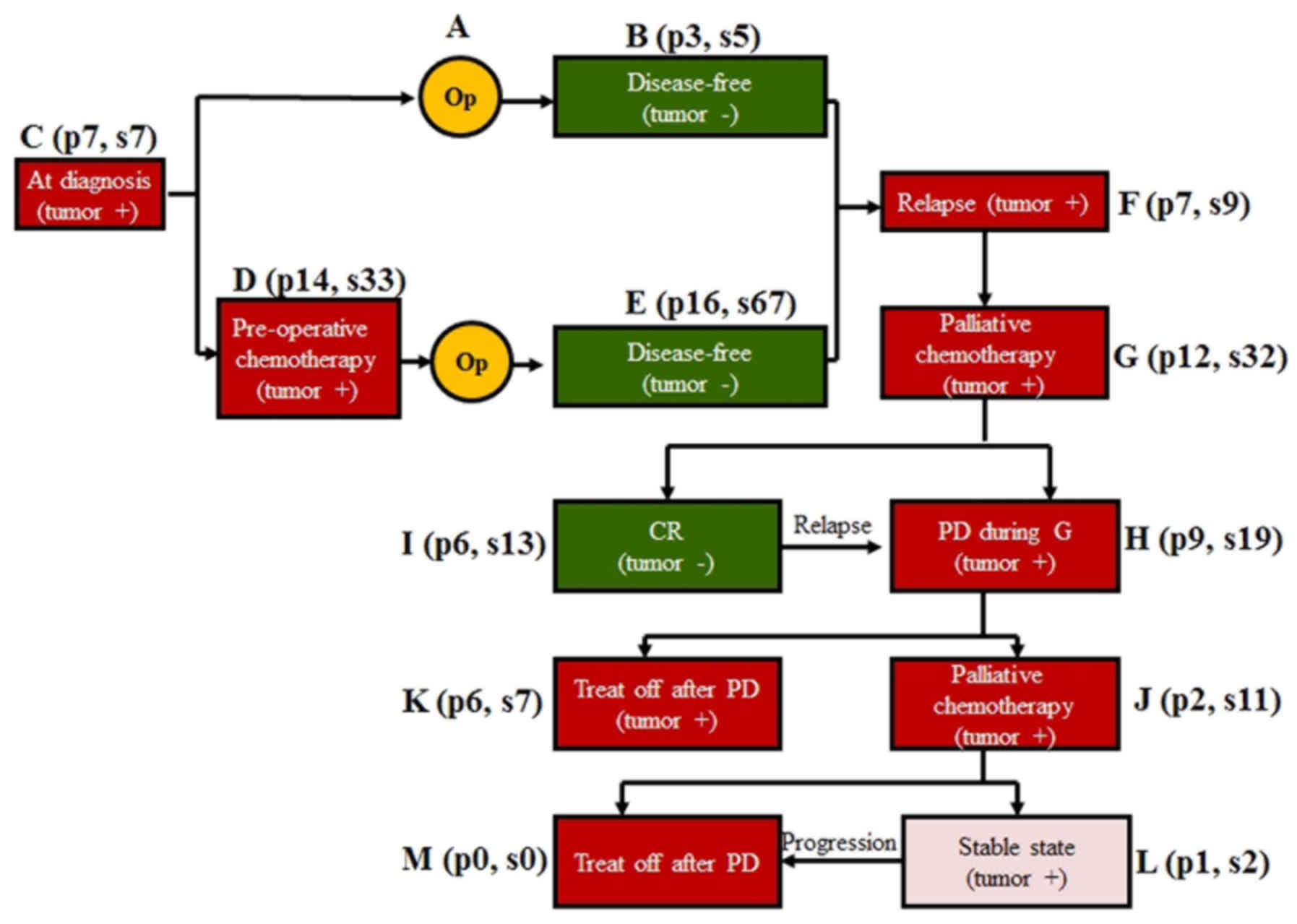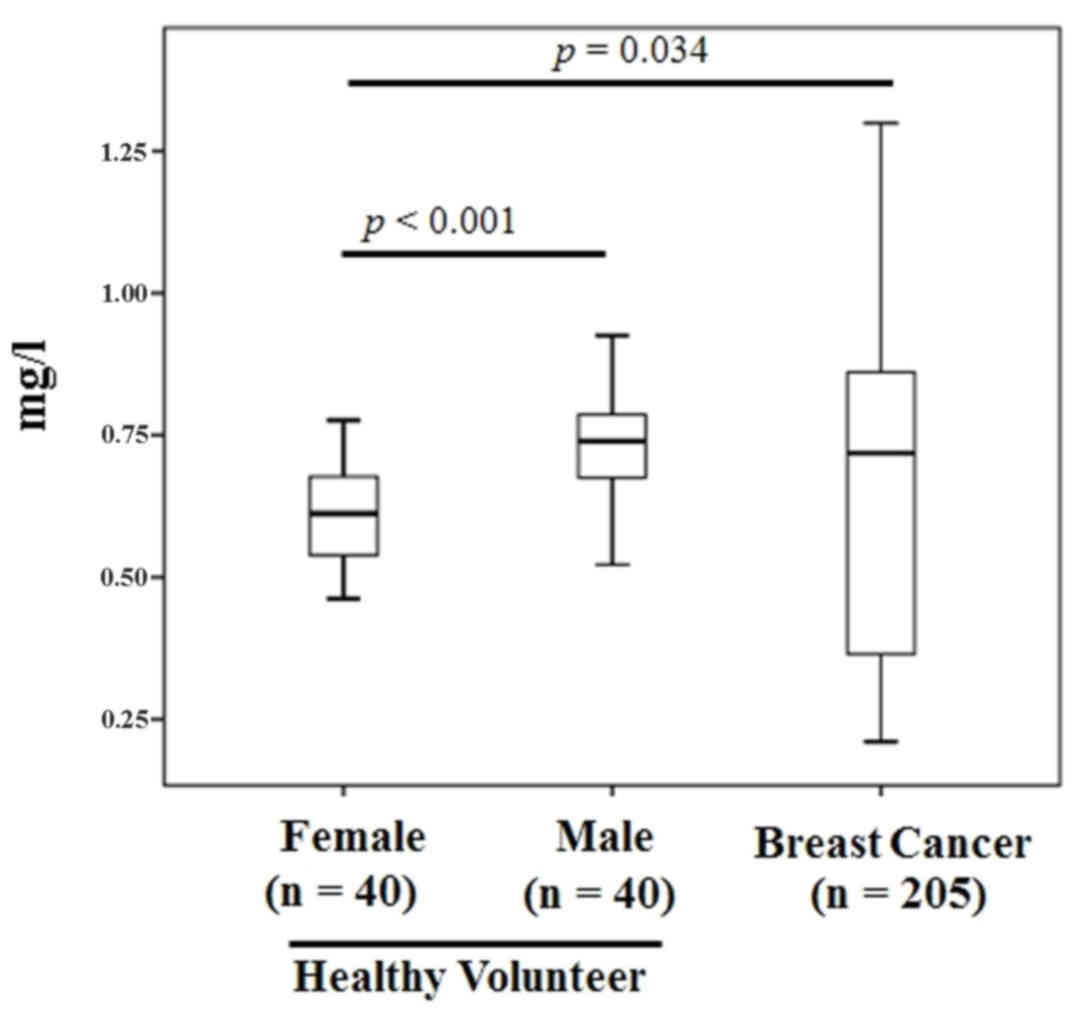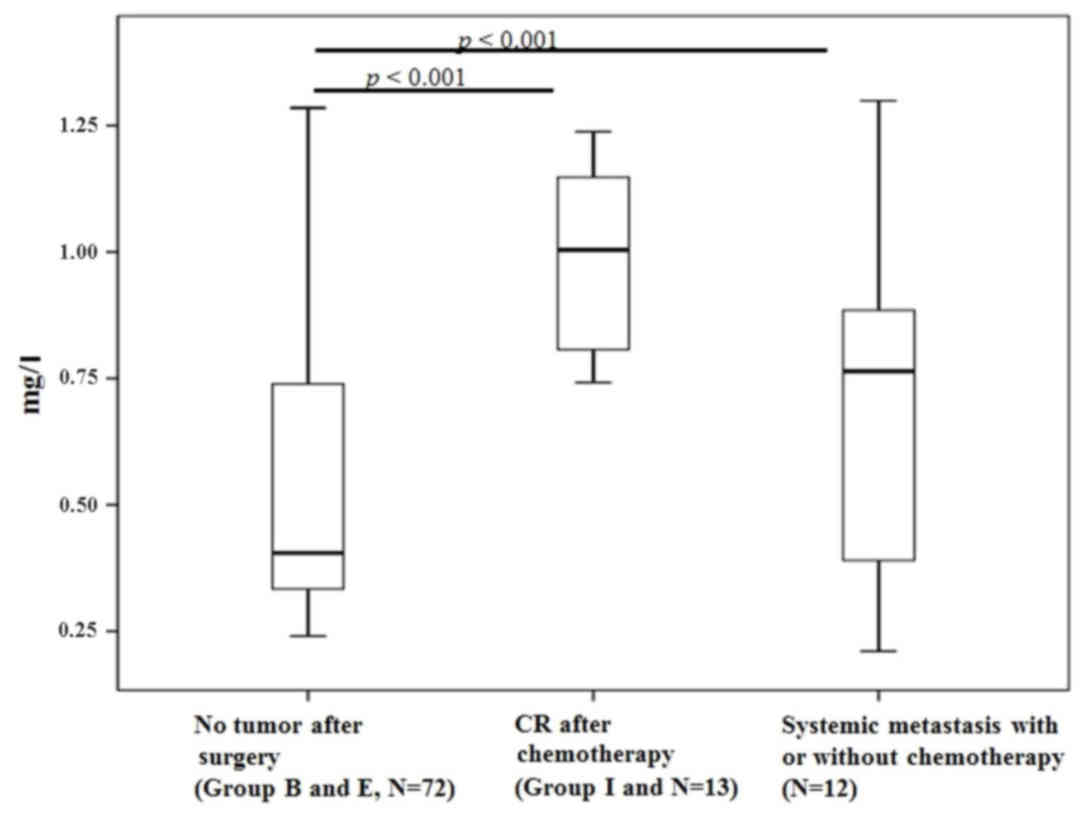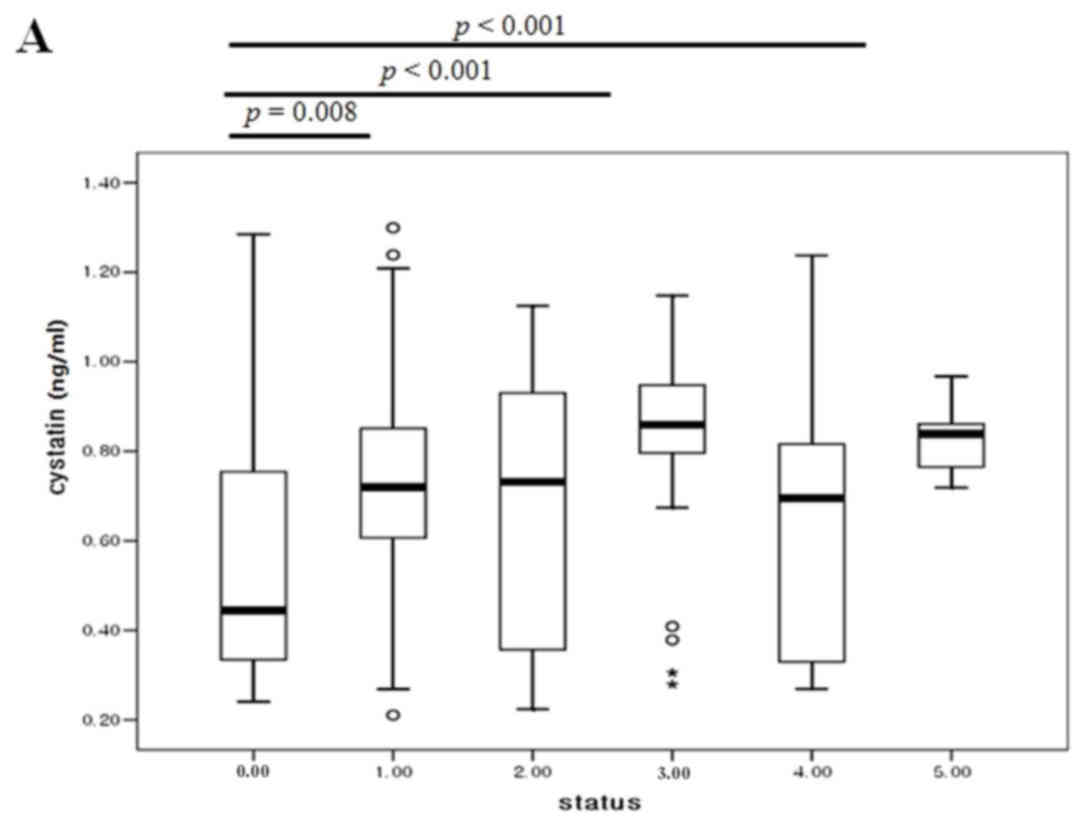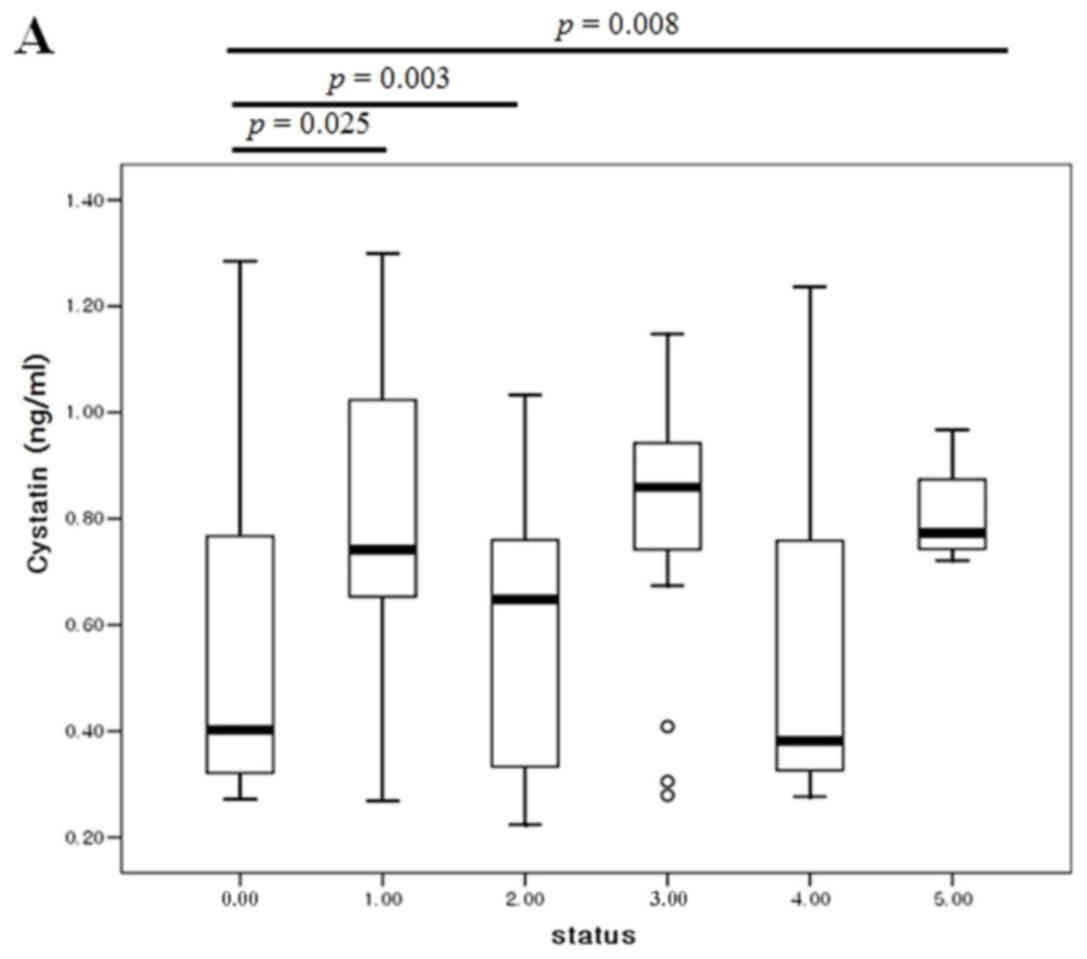|
1
|
Lankisch P, Wessalowski R, Maisonneuve P,
Haghgu M, Hermsen D and Kramm CM: Serum cystatic C is a suitable
marker for routine monitoring of renal function in pediatric cancer
patients, especially of very young age. Pediatr Blood Cancer.
46:767–772. 2006. View Article : Google Scholar : PubMed/NCBI
|
|
2
|
Chew-Harris JS, Florkowski CM, George PM
and Endre ZH: Comparative performances of the new chronic kidney
disease epidemiology equations incorporating cystatin-C for use in
cancer patients. Asia Pac J Clin Oncol. 11:142–151. 2015.
View Article : Google Scholar : PubMed/NCBI
|
|
3
|
Magnusson M, Hedblad B, Engström G,
Persson M, Nilsson P and Melander O: High and Cancer Study. J Int
Med. 274:192–199. 2013. View Article : Google Scholar
|
|
4
|
Sheahan K, Shuja S and Murnane MJ:
Cysteine protease activities and tumor development in human
colorectal carcinoma. Cancer Res. 49:3809–3814. 1989.PubMed/NCBI
|
|
5
|
Hirai K, Yokoyama M, Asano G and Tanaka S:
Expression of cathepsin B and cystatin-C in human colorectal
cancer. Human Pathol. 30:680–686. 1999. View Article : Google Scholar
|
|
6
|
Saleh Y, Sebzda T, Warwas M, Kopec W,
Ziólkowska J and Siewinski M: Expression of cystatin c in human
colorectal cancer tissues. J Exp Ther Oncol. 5:49–53.
2005.PubMed/NCBI
|
|
7
|
Zeng Q, Zhao Y, Yang Y, Zheng G, Wang G,
Zhang P, Cui Y, Su S and Li K: Expression of cystatin C in human
esophageal cancer. Tumori. 97:203–210. 2011. View Article : Google Scholar : PubMed/NCBI
|
|
8
|
Jiborn T, Abrahamson M, Gadaleanu V,
Lundwall A and Bjartell A: Aberrant expression of cystatin C in
prostate cancer is associated with neuroendocrine differentiation.
BJU Int. 98:186–196. 2006. View Article : Google Scholar
|
|
9
|
Yano M, Hirai K, Naito Z, Yokoyama M,
Ishiwata T, Shiraki Y, Inokuchi M and Asano G: Expression of
cathepsin B and cystatin C in human breast cancer. Surg Today.
31:385–389. 2001. View Article : Google Scholar : PubMed/NCBI
|
|
10
|
Sloane BF: Cathepsin B and cystatins:
Evidence for a role in cancer progression. Cancer Biol. 1:137–152.
1990.
|
|
11
|
Utsunomiya T, Hara Y, Kataoka A, Morita M,
Arakawa H, Mori M and Nishiyama S: Cystatin-like
metastasis-associated protein mRNA expression in human colorectal
cancer is associated with both liver metastasis and patient
survival. Clin Cancer Res. 8:2591–2594. 2002.PubMed/NCBI
|
|
12
|
Kuopio T, Kankaanranta A, Jalava P,
Kronqvist P, Kotkansalo T, Weber E and Collan Y: Cysteine
proteinase inhibitor cystatin A in breast cancer. Cancer Res.
58:432–436. 1998.PubMed/NCBI
|
|
13
|
Leto G, Tuminello FM, Pizzolanti G,
Montallo G, Soresi M and Gebbia N: Lysosomal cathepsins B and L and
stefin A blood levels in patients with hepatocellular carcinoma
and/or liver cirrhosis: Potential clinical implications. Oncology.
54:79–83. 1997. View Article : Google Scholar : PubMed/NCBI
|
|
14
|
Kos J, Stabuc B, Schweiger A, Krasovec M,
Cimerman N, Kopitar-Jerala N and Vrhovec I: Cathepsin B, H, L and
their inhibitors stefin A and cystatin-C in sera of melanoma
patients. Clin Cancer Res. 3:1815–1822. 1997.PubMed/NCBI
|
|
15
|
Kos J, Krasovec M, Cimerman N, Nielsen HJ,
Christensen IJ and Brunner N: Custeine proteinase inhibitors
stefin-A, stefin-B, and cystatin-C in sera from patients with
colorectal cancer: Relation to prognosis. Clin Cancer Res.
6:505–511. 2000.PubMed/NCBI
|
|
16
|
Ohara G, Miyazaki K, Kurishima K,
Kagohashi K, Ishikawa H, Satoh H and Hizawa N: Serum levels of
cystatin-C in elderly lung cancer patients. Oncol Lett. 3:303–306.
2012. View Article : Google Scholar : PubMed/NCBI
|
|
17
|
Decock J, Obermajer N, Vozelj S, Hendricks
W, Paridaens R and Kos J: Cathepsin B, cathepsin H, cathepsin X and
cystatin C in sera of patients with early-stage and inflammatory
breast cancer. Int J Biol Markers. 23:161–168. 2008. View Article : Google Scholar : PubMed/NCBI
|
|
18
|
Rha SY, Yang WI, Gong SJ, Kim JJ, Yoo NC,
Roh JK, Min JS, Lee KS, Kim BS and Chung HC: Correlation of tissue
and blood plasminogen activation system in breast cancer. Cancer
Lett. 150:137–145. 2000. View Article : Google Scholar : PubMed/NCBI
|
|
19
|
Hwang SJ, Yang Q, Meigs JB, Pearce EN and
Fox CS: A genome-wide association for kidney function and
endocrine-related traits in the NHLBI's Framingham Heart Study. BMC
Med Genet. 8 Suppl 1:S102007. View Article : Google Scholar : PubMed/NCBI
|
|
20
|
Finney H, Bates CJ and Price CP: Plasma
cystatin C determinations in healthy elderly population. Arch
Gerontol Geriatr. 29:75–94. 1999. View Article : Google Scholar : PubMed/NCBI
|
|
21
|
Norlund L, Grubb A, Fex G, Leksell H,
Nilsson JE, Schenck H and Hultberg B: The increase of plasma
homocysteine concentrations with age is partly due to the
deterioration of renal f unction as determined by plasma cystatin
C. Clin Chem Lab Med. 36:175–178. 1998. View Article : Google Scholar : PubMed/NCBI
|
|
22
|
Stabuc B, Vrhovec L, Stabuc-Silih M and
Cizej TE: Improved prediction of decreased creatinine clearance by
serum cystatin C: Use in cancer patients before and during
chemotherapy. Clin Chemis. 46:193–197. 2000.
|
|
23
|
Kume M, Yasui H, Yoshikawa Y, Horinouchi
M, Higashiguchi K, Kobayashi Y, Kuroda D, Hirano T, Hirai M and
Nakamura T: Transient elevation of serum cystatin C concentrations
during perioperative cisplatin-based chemotherapy in esophageal
cancer patients. Cancer Chemother Pharmacol. 69:1537–1544. 2012.
View Article : Google Scholar : PubMed/NCBI
|
|
24
|
Laurent-Matha V, Huesgen PF, Masson O,
Derocq D, Prébois C, Gary-Bobo M, Lecaille F, Rebiére B, Meurice G,
Oréar C, et al: Proteolysis of cystatin-C by cathepsin D in the
breast cancer microenvironment. FASEB J. 26:5172–5181. 2012.
View Article : Google Scholar : PubMed/NCBI
|
|
25
|
Nishikawa H, Ozaki Y, Nakanishi T,
Blomgren K, Tada T, Arakawa A and Suzumori K: The role of cathepsin
B and cystatin C in the mechanisms of invasion by ovarian cancer.
Gynecol Oncol. 92:881–886. 2004. View Article : Google Scholar : PubMed/NCBI
|
|
26
|
Wegiel B, Jiborn T, Abrahamson M,
Helczynski L, Otterbein L, Persson JL and Bjartell A: Cystatin C is
downregulated in prostate cancer and modulates invasion of prostate
cancer cells vis MAPK/Erk and androgen receptor pathways. PLos One.
4:e79532009. View Article : Google Scholar : PubMed/NCBI
|
|
27
|
Sokol JP and Schiemann WP: Cystatin C
antagonizes transforming growth factor beta signaling in normal and
cancer cells. Mol Cancer Res. 2:183–195. 2004.PubMed/NCBI
|
|
28
|
Tian M and Schiemann WP: Preclinical
efficacy of cystatin C to target the oncogenic activity of
transforming growth factor Beta in breast cancer. Transl Oncol.
2:174–183. 2009. View Article : Google Scholar : PubMed/NCBI
|
|
29
|
Vigneswaran N, Wu J, Muller S, Zacharias
W, Narendran S and Middleton L: Expression analysis of cystatin C
and M in laser-capture microdissectioned human breast cancer
cells-a preliminary study. Pathol Res Pract. 200:753–762. 2005.
View Article : Google Scholar : PubMed/NCBI
|















